List of Authors
>>About this blog
Recent blog post
|
[Silver]
January 15, 2015 14:00
This year's Tokyo Marathon 2015 will be held on February 22nd.
Prior to that, the marathon course was divided into five sessions, from Saturday, January 24 to February 21.
Every Saturday we visit historic sites and shop at the shopping streets of the course.
There is a fun  walking walking  event. Participation fee is free event. Participation fee is free , but you need to apply in advance. , but you need to apply in advance.
The cost of shopping etc. is borne by the individual, but in Chuo-ku edition, you drink amazake and buy puppet ware in Ningyocho.
In Tsukishima, you can eat lunch such as monjayaki and buy long-established Japanese sweets.
I have been participating every year since 2007. For details, please refer to the following URL.
Let's meet you on the walking tour of the Tokyo Marathon Course!
・・・・・・・・・・・・・・・・・・・・・・・・・・・・・・・・・・・・・
Would you like to walk on the Tokyo Marathon Course?
Along with the "Tokyo Grand Marathon Festival 2015" to be held on February 22, 2015 (Sunday), a "walking tour" will be held guided by a guide from the Tokyo City Guide Club (TCGC).
Walk all routes while going around sightseeing points on the course (1-6), which divides six from the Tokyo Metropolitan Government to the goal Tokyo Big Sight, from sightseeing spots. The required time is about 2.5 hours to 3 hours each day, and the participation fee is free. On February 22, when the marathon will be held, a tour around Kaminarimon in Senso-ji Temple (7) will be held.
The schedule will be held on the following schedule, so please specify the date and time you wish to participate before applying.
We look forward to your application.
Please click here for more information.
http://tcgc.5.pro.tok2.com/event/tokyo%20marathon2015.pdf
Please click here for more details.
/archive/2013/02/post-1546.html
/archive/2014/02/post-1911.html
[Mr.Chuo-ku]
January 15, 2015 09:00
Opened in July 2012 as a general information center for Tsukiji Outer Market.
In addition to providing guidance to visitors, providing sightseeing and traffic information in the surrounding area, selling original goods, special event spaces and rest spaces are set up.
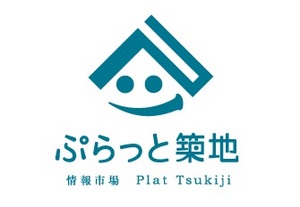
(Information as of January 2015 ↓)
■Platto Tsukiji
Weekday / Saturday / 8: 00-14: 00
Holidays, Holidays / 10:00 to 14:00
Holidays/New Year holidays
■Rest area
Weekday / Saturday / 6: 00-16: 00
Holidays, Holidays: 7: 00-16: 00
Holidays/New Year holidays
〒104-0045 Tsukiji 4-16-2,000 Company Building 1F, Tsukiji 4-chome, Chuo-ku, Tokyo
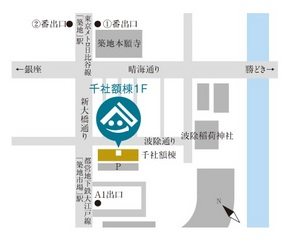
[Taro Edo]
January 14, 2015 12:00
I went to the cold bathing tournament at Tetsunan Inari Shrine, a New Year's tradition in Chuo-ku, Tokyo.
1) Date and time
It was carried out from 11:00 am to 11:35 am on Sunday, January 11, 2015.
2) Venue
1-6-7 Minato, Chuo-ku, Tokyo
3) Overview
It was started as a ritual of purification for sound health for one year.
It started in 1955 and this is the 60th time this year.
After Miyashi's exorcism, a careful preparatory exercise is carried out, and about 100 people in loincloths (for women, white clothing) enter the aquarium with ice pillars.
4) The significance of bathing in the cold
Every year in the beginning of the New Year, during the cold bath at the Tetsugansu Inari Shrine is a Shinto ritual that prays for sound health by bathing in cold water in front of the shrine in the New Year and performing a purification ceremony to clean the mind and body. It is a pure Japanese language that is not found in Chinese language, so it can be seen that it is a custom unique to Japan.
It is said that the 60th anniversary of the festival was revived in 2015 by local people who were saved from epidemic diseases through thin clothes and bathing in the Edo period with gratitude to guardian god.
Since it was introduced to the top in the "Water Festival" section of the Adult Metropolitan Area Walking Magazine "Walking Master Mook / Festival & Event Calendar 2009" issued by the Kotsu Shimbun in 2008, Kanto's best tradition It has gained popularity as a prestigious water festival, and the number of participants and visitors increases every year.
5) How to bathe in the cold
Nara period, who was born in Usa-gun, Oita Prefecture in 1862, revived the purification method of Mitake Shrine, located at the summit of Mt. Mitake (929m), Ome City, Tokyo. There are a number of schools, but there is no big difference, and the cold bathing performed at Tetsugansu Inari Shrine is also performed by the purification method of the river surface style under the guidance of the Tokyo Shrine Agency's Narinari Event Michihiko (Guman) and Naotsushi Shinoheikawa Shrine Miyaji. It is done.
After going out on the public road and running around the shrine, as the Tetsugunshu Hayashi played in Kagura Hall flows, they performed bird boats for preparatory exercises, entered a cool water tank with large icicles, immersed in cold water to the chest, and soaked in cold water...."I purify my mind and body while doing the soul while chanting." After the end, we will conduct a reorganization campaign with a bird boat again and finish the cold purification ceremony.
The Arido Okami is the gods responsible for the exorcism in Shinto.•The filth flows from the river to the sea.•Fast-opening Tobi Sales (Since on the Seabed)•It is the four gods of swallowing the filthyness), Ki Fukido (breathing in the root country), and Hasasurahiuri (the sins and filth brought into the root country and loses). It is also called the four gods of exorcism, and it is a thankful gods who release our sins and filth deep underground based on the same concept as the current waste disposal. Therefore, during the water line, he recites Arido Okami many times. Miyaji's felicitation "great exorcism Lyrics" in great exorcism in June and December recites the relay of sin and filth by the Oga and others, so I understand you are listening well.
The details are as follows.
1) Run around the shrine
2) Bird boat event (Torifuneiji)
3) The soul (Furitama)
4) Yuken event (Otakebigyoji)
5) Yuzume event (Okorobigyoji)
6) Kebuki event
7) Kanmisogi
Source: Information for bathing participants of the Iron Gunshu Inari Shrine Yayoikai
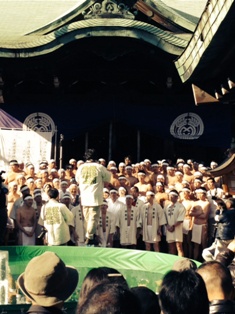 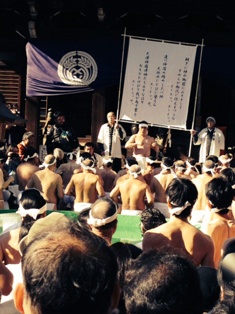
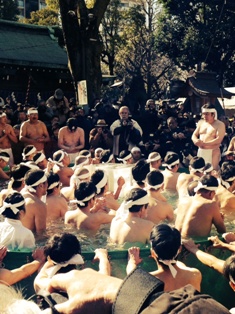 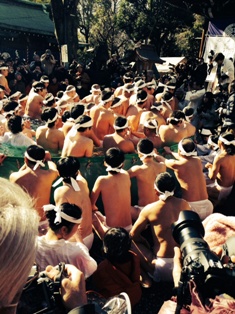
[Silver]
January 13, 2015 09:00
We have previously posted pine decorations for New Year's Day.
At the "pine decoration" that celebrates the New Year, "how to cut bamboo" is cut diagonally, cut flat on the nodes, and decorate bamboo bamboo grass with pine, It's different at each shop.
When I introduced this year's "Nihonbashi Seven Lucky Gods Tour", a few customers asked me a question.
It seems that Kadomatsu varies from region to region.
First of all, as for the cut, it seems that it has been cut sideways since ancient times, but since the Warring States period, it has been cut diagonally especially in samurai. It seems that this is called "Sogi".
In places where the tradition of Kyoto is valued, bamboo still does not cut diagonally. So, in Kyoto, there are a lot of "sunto".
In addition to these two basic cutting methods, recently, the top of the bamboo is cut sideways and used a bamboo node to leave the shape of the mouth, so that it is not dangerous.
This time, I photographed the pine decorations of a hotel called a Western Ryokan.
This is the Marriott Hotel "Sogi" at the Kyobashi Trust Tower.
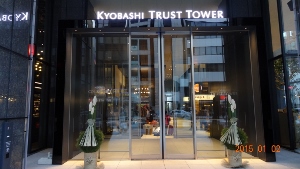
Pine decoration of Ginza Kokusai Hotel. It's a small body.
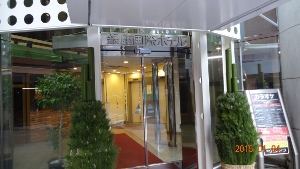
The pine decoration of the Ginza Grand Hotel is "Sogi".

The pine decoration of the Millenium Mitsui Garden Hotel, which opened in December 2014, is Sogi.
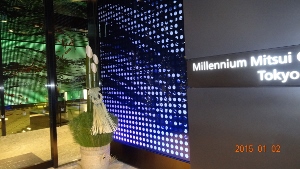
The pine decorations of Mitsui Garden Hotel Ginza Pru Mie are "Sog + Mouth"
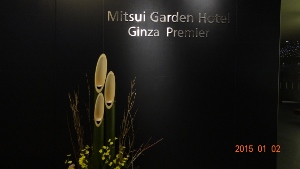
The pine decoration of Courtyard Marriott Ginza Tobu Hotel is "Sunto".
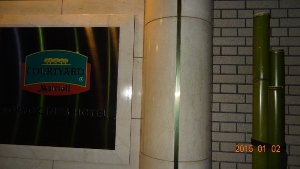
And I went to Uchisaiwai-cho and saw the pine decorations of the oldest hotel in Japan, which celebrated its 125th anniversary this year.
This is "Sagi + Mouth" with the upper part of the bamboo flat, the nodes in the middle, and the lower part with a modest opening of the mouth.
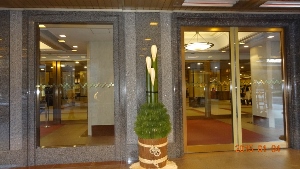
Each hotel seemed to be particular about it, and it was a very interesting exploration.
(This is the past article.)
/archive/2010/01/post-237.html
/archive/2010/01/post-239.html
Hundred Views of Chuo-ku| Ningyocho, Hamacho, Higashinihombashi area| Tsukuda, Tsukishima, Kachidoki and Harumi areas| Nihonbashi, Kyobashi and Yaesu areas| History, culture| Tsukiji, Shintomi, Minato area| Kayabacho, Hatchobori, and Shinkawa areas| Ginza area
Page top▲
[Sam]
January 8, 2015 09:00
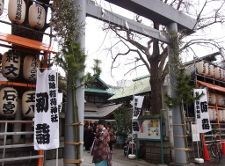 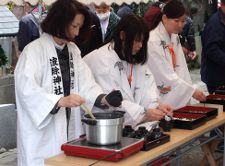
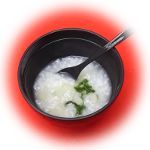 On January 7, at Tsukiji Namiki Inari Shrine, a "Seven herbs Shinto ritual festival" was held at 11:00, followed by seven herbs porridge to worshipers free of charge on the grounds. On January 7, at Tsukiji Namiki Inari Shrine, a "Seven herbs Shinto ritual festival" was held at 11:00, followed by seven herbs porridge to worshipers free of charge on the grounds.
This day is one of the five festivals, "Human's Day Festival", and at one milestone of the New Year's event, spring seven herbs (seri, Nazuna, Gokyo, Hakobera, Hotokenoza, Suzuna, Suzushiro) in hope of sound health.
It is a special herb porridge made using rice from the shrine's "Goshinden (a rice field that makes rice to be offered to God)" and has been established as an annual event. .
The opening time is from 11:00 to 12:00 (for the first 100 people). It will end as soon as the seven herbs are gone.
It is a custom of working on the stomach and intestines tired of the New Year's treat, not overlooking one aspect of nutritional supplement in winter, when green vegetables tend to be short, and feeling wisdom from ancient times.
Under the cold sky, we had a hot "New Year's Taste".
1
|
Links
|
![]() walking
walking![]()
![]() event. Participation fee is free
event. Participation fee is free![]() , but you need to apply in advance.
, but you need to apply in advance.















